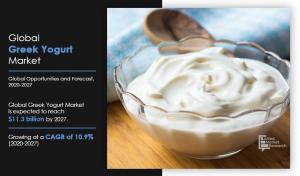Greek Yogurt Market Report
Global Greek Yogurt market witnesses robust growth, reaching $11.2 billion by 2027 with a CAGR of 10.9%. Europe dominates with a 44.1% market share in 2019.
— Allied Market Research
WILMINGTON,NEW CASTLE, DELAWARE 19801 USA, UNITED STATE, January 29, 2024 /EINPresswire.com/ — According to a new report published by Allied Market Research titled, “Greek Yogurt Market by Type, Flavor, Distribution Channel, and Source: Opportunity Analysis and Industry Forecast, 2020–2027,” The Greek yogurt market size was valued at $7.2 billion in 2019, and is projected to reach $11.2 billion by 2027, growing at a CAGR of 10.9% from 2020 to 2027. Europe dominated the market in 2019, accounting for 44.1% of the total market share. The Greek yogurt market exhibits an incremental revenue opportunity of $4.0 billion from 2019–2027.
▶ 𝐆𝐞𝐭 𝐅𝐮𝐥𝐥 𝐀𝐜𝐜𝐞𝐬𝐬 𝐭𝐨 𝐒𝐚𝐦𝐩𝐥𝐞 𝐂𝐨𝐩𝐲 :
The Greek yogurt market holds a substantial scope for the market growth. The market is currently in its growth stage; however, its contribution to the global market is expected to increase significantly during the forecast period. Increase in demand of flavored yogurt has enforced the market to produce innovative products such as strawberry, blueberry, and vanilla flavors. Growth of the global population and rise in per capita income boost the market growth, thus increasing the production of dairy items. The change in taste and preference of consumers affected the sales in response to dietary concerns for manufacturers to develop differentiated products. Numerous players are entering the Greek yogurt market with innovative food products, using milk as their base. Emerging innovative food items are expected to increase the market competition in the years to come.
The growth in the population in the developing countries, such as China and India, has increased the demand for yogurt, butter, and cheese to fulfill their food requirement. This increase in population coupled with per capita income has increased the demand for dairy products, further increasing the production of milk. In emerging countries, per capita income is more as compared to developed countries and hence, the consumption of dairy products such as yogurt, butter, cheese, butter milk, and flavored milk is eventually higher.
▶ 𝐆𝐞𝐭 𝐑𝐞𝐩𝐨𝐫𝐭 𝐂𝐮𝐬𝐭𝐨𝐦𝐢𝐳𝐚𝐭𝐢𝐨𝐧 :
The Greek yogurt market is segmented into type, flavor, distribution channel, source, and region. By product type, it is categorized into whole milk, low fat, and nonfat. The whole milk segment was valued at $2.6 billion and is expected to growth with a CAGR of 10.9 (2019-2027) to reach $3.9 billion by 2027. The nonfat segment is expected to be the fastest growing segment with a CAGR of 12.2% during the forecast period. The fastest growth of nonfat segment is attributed to the increased demand for consumers for different types of dairy products made by organic and non-dairy milks.
By flavor, it is categorized into plain, strawberry, blueberry, vanilla, and others. By distribution channel, the market is divided into supermarket/hypermarket, convenience stores, online stores, and others. By source, it is bifurcated into organic, and conventional. By region, the market is analyzed across North America (the U.S., Canada, and Mexico), Europe (Germany, France, UK, Italy, Spain, and Rest of Europe), Asia-Pacific (China, India, Japan, Australia, Rest of Asia-Pacific), and LAMEA (Latin America, Middle East, and Africa.). Countries such as Australia, the U.S., and the UK, NORDIC countries, India, China, and ASEAN countries are the largest spenders on dairy products. In addition, factors such as product availability, socio-economic status, per capita expenditure, and consumer purchasing power are responsible for the growth of the Greek yogurt market in these regions.
▶ 𝐁𝐔𝐘 𝐍𝐎𝐖 :
[ 𝐊𝐞𝐲 𝐅𝐢𝐧𝐝𝐢𝐧𝐠𝐬 𝐎𝐟 𝐓𝐡𝐞 𝐒𝐭𝐮𝐝𝐲 ]
▶️ The low fat products segment is expected to grow at a CAGR of 11.1% during the forecast period.
▶️ Europe is anticipated to dominate the Greek yogurt market growth, registering a CAGR of 10.5%.
▶️ Conventional Greek yogurt is projected to contribute with highest Greek yogurt market share during the forecast time period, with around 95% market share in 2027, and CAGR of 10.8%
▶️ The supermarket/hypermarket distribution segment is anticipated to dominate the global Greek yogurt market, with a CAGR of 11.3% during the forecast period.
▶️ The strawberry segment is estimated to grow at a CAGR of 10.8% during the forecast period.
▶ 𝐒𝐏𝐄𝐀𝐊 𝐖𝐈𝐓𝐇 𝐀𝐍𝐀𝐋𝐘𝐒𝐓 :
The global market is fragmented with the presence of several market participants across various regions. The strong presence private label brands offers tough competition to the global players. The key players operating in the global Greek yogurt market include –
– 𝗖𝗵𝗼𝗯𝗮𝗻𝗶 𝗚𝗹𝗼𝗯𝗮𝗹 𝗛𝗼𝗹𝗱𝗶𝗻𝗴𝘀, 𝗜𝗻𝗰.
– 𝗙𝗔𝗚𝗘 𝗜𝗻𝘁𝗲𝗿𝗻𝗮𝘁𝗶𝗼𝗻𝗮𝗹 𝗦.𝗔
– 𝗚𝗲𝗻𝗲𝗿𝗮𝗹 𝗠𝗶𝗹𝗹𝘀 𝗜𝗻𝗰. (𝗬𝗼𝗽𝗹𝗮𝗶𝘁)
– 𝗗𝗮𝗻𝗼𝗻𝗲 𝗦.𝗔.
– 𝗦𝘁𝗼𝗻𝘆𝗳𝗶𝗲𝗹𝗱 𝗙𝗮𝗿𝗺 (𝗟𝗮𝗰𝘁𝗮𝗹𝗶𝘀)
– 𝗡𝗲𝘀𝘁𝗹é 𝗦.𝗔.
– 𝗨𝗻𝘁𝗲𝗿𝗻𝗲𝗵𝗺𝗲𝗻𝘀𝗴𝗿𝘂𝗽𝗽𝗲 𝗧𝗵𝗲𝗼 𝗠ü𝗹𝗹𝗲𝗿
– 𝗧𝗵𝗲 𝗛𝗮𝗶𝗻 𝗖𝗲𝗹𝗲𝘀𝘁𝗶𝗮𝗹 𝗚𝗿𝗼𝘂𝗽 (𝗧𝗵𝗲 𝗚𝗿𝗲𝗲𝗸 𝗚𝗼𝗱𝘀)
– 𝗧𝗵𝗲 𝗞𝗿𝗼𝗴𝗲𝗿 𝗖𝗼.
– 𝗪𝗮𝗹𝗹𝗮𝗯𝘆 𝗢𝗿𝗴𝗮𝗻𝗶𝗰
𝐀𝐛𝐨𝐮𝐭 𝐔𝐬
Allied Market Research (AMR) is a full-service market research and business-consulting wing of Allied Analytics LLP based in Portland, Oregon. Allied Market Research provides global enterprises as well as medium and small businesses with unmatched quality of “Market Research Reports” and “Business Intelligence Solutions.” AMR has a targeted view to provide business insights and consulting to assist its clients to make strategic business decisions and achieve sustainable growth in their respective market domain.
Pawan Kumar, the CEO of Allied Market Research, is leading the organization toward providing high-quality data and insights. We are in professional corporate relations with various companies and this helps us in digging out market data that helps us generate accurate research data tables and confirms utmost accuracy in our market forecasting. Each and every data presented in the reports published by us is extracted through primary interviews with top officials from leading companies of domain concerned. Our secondary data procurement methodology includes deep online and offline research and discussion with knowledgeable professionals and analysts in the industry.
David Correa
Allied Market Research
+ + +1 800-792-5285
email us here
Visit us on social media:
Facebook
Twitter
LinkedIn
![]()
Article originally published on www.einpresswire.com as Reaching $11.2 Billion by 2027.





